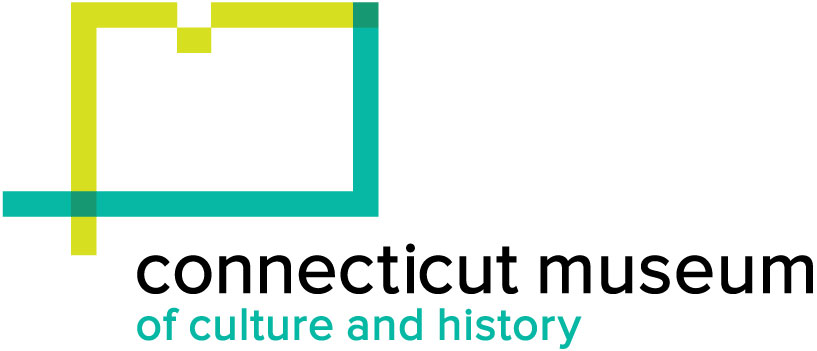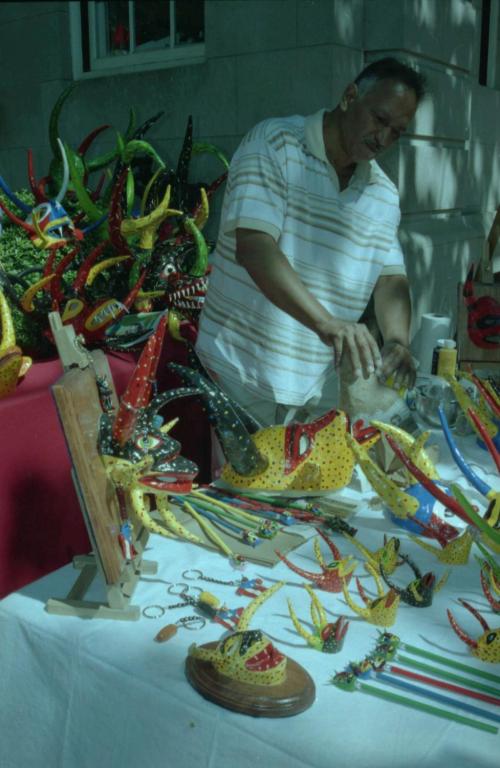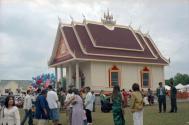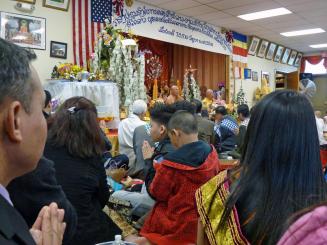Southern New England Apprenticeship Program Year 9 - Vejigante Masks; and Lao Temple Dedication
SubjectPortrait of
Lydia Pérez
(Puerto Rican)
SubjectPortrait of
Angel Sánchez Ortíz
(Puerto Rican)
DateJune 2007
Mediumnegatives
ClassificationsGraphics
Credit LineConnecticut Cultural Heritage Arts Program collections
CopyrightIn Copyright
Object number2015.196.346.1-.24
Description2015.196.346.1-.9 & 2015.196.346.24: Photos from a required public presentation of the Southern New England Apprenticeship Program Year 9 team in Puerto Rican vejigante mask making. Teaching artist Angel Sanchez with apprentice Lydia Perez.
2015.196.346.1-.9: Images showing presentation by Angel Sanchez Ortiz of his vejigante masks at First Works Providence Festival, June 16, 2007
2015.196.346.24: Image showing dancers from Lydia Perez' dance group performing in a comparsa (procession) at First Works Providence Festival wearing vejigante and other papier-mâché masks, with Providence skyline visible
2015.196.346.10-.23: Photos showing the Lao Festival and new small temple dedication at the Wat Lao Buddha Ariyamettaram Temple in Morris, Connecticut on June 10, 2007.
2015.196.346.11: Image showing entrance to the temple grounds
2015.196.346.12: Image showing a Buddhist monk sitting on parking lot ground outside Lao temple
2015.196.346.13: Image showing people waiting to enter Lao temple
2015.196.346.14: Image showing people entering the new temple building
2015.196.346.15-.16: Images showing people gathered for Lao temple dedication ceremony
2015.196.346.17: Image showing speakers at the podium during the new temple building dedication - the artist/builder/resident monk Khout is on the right
2015.196.346.18: Image showing person standing behind large drum by temple
2015.196.346.19: Image showing several people seated on floor, eating inside temple
2015.196.346.20: Image showing indoor temple altar
2015.196.346.21-.22: Images showing several people near indoor altar
2015.196.346.23: Image showing people outside of Lao temple
NotesSubject Note for 2015.196.346.1-.9 & 2015.196.346.24: Photos from a required public presentation of the Southern New England Apprenticeship Program Year 9 team in Puerto Rican vejigante mask making. Teaching artist Angel Sanchez with apprentice Lydia Perez. Angel Sanchez Ortiz and Lydia Perez created several vejigante masks of the type made in Ponce, Puerto Rico, for festivals and parades called comparsas. Lydia used the ones she learned to make in her main-stage performance in Providence at the First Works Festival. Angel displayed his masks at the festival.2015.196.346.1-.9: Images showing presentation by Angel Sanchez Ortiz of his vejigante masks at First Works Providence Festival, June 16, 2007
2015.196.346.24: Image showing dancers from Lydia Perez' dance group performing in a comparsa (procession) at First Works Providence Festival wearing vejigante and other papier-mâché masks, with Providence skyline visible
2015.196.346.10-.23: Photos showing the Lao Festival and new small temple dedication at the Wat Lao Buddha Ariyamettaram Temple in Morris, Connecticut on June 10, 2007.
2015.196.346.11: Image showing entrance to the temple grounds
2015.196.346.12: Image showing a Buddhist monk sitting on parking lot ground outside Lao temple
2015.196.346.13: Image showing people waiting to enter Lao temple
2015.196.346.14: Image showing people entering the new temple building
2015.196.346.15-.16: Images showing people gathered for Lao temple dedication ceremony
2015.196.346.17: Image showing speakers at the podium during the new temple building dedication - the artist/builder/resident monk Khout is on the right
2015.196.346.18: Image showing person standing behind large drum by temple
2015.196.346.19: Image showing several people seated on floor, eating inside temple
2015.196.346.20: Image showing indoor temple altar
2015.196.346.21-.22: Images showing several people near indoor altar
2015.196.346.23: Image showing people outside of Lao temple
Subject Note: The Southern New England Traditional Arts Apprenticeship Program is a CCHAP initiative since 1997 that fosters the sharing of community-based traditional (folk) artistic skills through the apprenticeship learning model of regular, intensive, one-on-one teaching by a skilled mentor artist to a student/apprentice. The program pairs master artists from Rhode Island, Massachusetts, or Connecticut with apprentices from one of the other states, as a way to knit together members of the same community or group across state lines. Teaching and learning traditional arts help to sustain cultural expressions that are central to a community, while also strengthening festivals, arts activities and events when master/apprentice artists perform or demonstrate results of their cooperative learning to public audiences. The Connecticut Cultural Heritage Arts Program at the Connecticut Historical Society manages the program in collaboration with the Folk Arts Program at the Massachusetts Cultural Council and independent folklorist Winifred Lambrecht who has a deep knowledge of the folk arts landscape of Rhode Island. Primary funding for the program comes from the National Endowment for the Arts, with support also from the Connecticut Commission on the Arts, the Institute for Community Research, and the Connecticut Historical Society.
Biographical Note: Lydia Perez has been a teacher in the Southern New England Traditional Arts Apprenticeship Program in 1999-2000 to student Maria Perez Colon, and Menen Osorio in 1998-1999, both in Puerto Rican bomba dance. Lydia has been an apprentice in the program three times: with mentor Angel Sanchez Ortiz in vejigante making in 2006-2007, and 2015-2016 and 2016-2017 with mentor Carlos Santiago Arroyo in santos carving. Lydia is a longtime arts activist and practitioner of Puerto Rican bomba and plena dance and music with her family joining her in the group Yoruba II. She has developed the Puerto Rican Institute for Arts and Advocacy, an organization for education, performance, and advocacy for Puerto Rican arts and culture, and gives performances and teachings all over New England.
Biographical Note: Angel Sánchez Ortiz, based in Holyoke, Massachusetts, is a maker of traditional Puerto Rican vejigante masks made of painted paper maché that are worn by costumed dancers representing demons and playfully scary figures at celebrations including Carnival and the St. James de Campostela Festival held in Ponce and Loiza, Puerto Rico. This festival has also been held in several cities around New England, including New Haven for some years in the 1990s. Today’s Puerto Rican masks are the result of a blend of the African, Spanish, and native Táíno cultures. Africans, who were forced to come to the island as slaves, brought with them a rich and ancient tradition of wearing masks during rituals. Angel taught the process of Puerto Rican vejigante-making to Lydia Perez in the Southern New England Traditional Arts Program in 2006-2007.
Angel Sánchez Ortíz was born in Ponce and raised in Barrio San Antón in Puerto Rico. He grew up living the traditional Carnival festivities in February each year. During this time, family and friends were immersed in the celebration heralding the beginning of Lent. These festivities are more vibrant in the poorer areas of Ponce. He participated in the making of masks and costumes as they got ready for the Carnival in the Calle Cuatro, Bélgica, Cantera and Playa de Ponce. These masks are made out of papier-maché and depict animals with fantastic imagery. Angel Sánchez Ortíz made his own masks at the age of seven after observing artisans such as Mariano, Geño and others. By the time he was nine years old he had completed several other masks with vivid splashes of color and curved horns with the encouragement of his art teacher. Sánchez Ortíz continued his craft after immigrating to the Pioneer Valley of Massachusetts in 1989, teaching children and adolescents this cultural tradition through workshops and other activities. He has exhibited his work at the Puerto Rican Cultural Center, the Spanish American Union, Worcester Art Museum, Wheeler Gallery at Umass, Holyoke Community College, at Hartford Public Library, at Lowell Folk Festival and many other events around southern New England. Angel is a strong advocate for transmission of Puerto Rican culture through mask-making and other paper crafts.
Subject Note: Wat Lao Buddha Ariyamett Aram Temple, Morris CT is a center for the Lao community and their Buddhist worship, situated on several acres of land in rural northwestern Connecticut. Founded in 2002, the temple has beautiful statues of deities and traditional figures as well as several buildings for worship and community gatherings, many of those decorated and constructed in traditional fashion by the resident monk. Khoutavong Yongchaiyuth, traditional Lao ceremonial woodcarver, serves as the resident monk of the Wat Lao Ariyamettaram Lao temple in Morris, rural northwestern Connecticut, having moved there from the temple in Danbury. Khout has been a monk since he was fourteen years old, and in the temple in Laos he learned woodcarving, sculpture, stonemasonry, and painting. He was brought to the US in 1999 by the resident monk in Danbury to build decorative stone and woodwork, and Khout practices the same traditional crafts at the temple in Morris where he serves the spiritual needs of the Lao community. CCHAP has documented activities at the temple over many years, including New Year festivals, the water ceremony, temple dedications, and led a cultural tourism group to visit the temple in 2006. CCHAP connected the temple and community to a 2007 WNPR project on health care in Connecticut ethnic communities. As part of the Southern New England Traditional Arts Apprenticeship Program Year 18 (2015-2016), Khout was a mentor to two monks, Xaiyo and Somchay, from the Smithfield RI Lao temple who came to the temple to learn how to build, restore, and decorate Laotian spiritual statues and buildings. Over an intensive few weeks, the young monks from RI gained skills of designing, molding, casting, cutting, and applying that helped them to revitalize the older structures at their temple. They presented their learning at a festival at the temple in 2016.
Subject Note for 2015.196.346.10-.23: Connecticut was a major resettlement site for Southeast Asians in the 1980's. The Lao population numbers over 3000, living primarily in urban areas such as New Britain, Bridgeport, East Hartford, and Danbury and for a time in the 1990s-2007, in rural eastern Connecticut. While many Lao have found employment in factories, service industries, farming, and trades such as food, they continue to face barriers of language, lack of education, and lower income levels, all against a common backdrop of serious emotional wounds from the Viet Nam War era. Youth aged 10 - 19 years old have been by far the largest age group among Connecticut Southeast Asians. Maintaining young peoples’ awareness of heritage, culture, values, and language is a major goal of Lao leaders and parents. The Lao community sustains its traditional cultural practices in several ways. Several temples around the state provide gathering places where Buddhist monks and nuns offer spiritual services and cultural festivals. The largest temple is in Morris, where the resident monk Khoutavong has created exquisite Buddhist statues and traditional architecture with symbolic carvings, ornamentation, and shrines. Dancer and educator Manola Sidara developed and has directed Lao Narthasin, a traditional dance group now in its third generation of dancers. They perform classical, folk, and social dances that highlight cultural values such as respectful behavior and appreciation for elders. Manola also specializes in creating ceremonial decorations that express wellness, spirituality, and bonding during community celebrations, and she also promotes health and healing through her work as a master chef. The Lao Association of Connecticut formed in 1980 to unite the community and assist in economic development, cultural preservation, education, and health. For many years LAC offered classes in language, history, food and medicine, verbal arts, traditional music, and singing at Jefferson School in New Britain, and the group organizes several heritage festivals each year at the Morris temple that are attended by hundreds of Lao people. Other Lao community groups around the state also develop and present spiritual and cultural programs as well as health initiatives.
Biographical Note: Khoutavong Yongchaiyuth, traditional Lao ceremonial woodcarver, serves as the resident monk of the Wat Lao Ariyamettaram Lao temple in Morris, rural northwestern Connecticut, having moved there from the temple in Danbury. Khout has been a monk since he was fourteen years old, and in the temple in Laos he learned woodcarving, sculpture, stonemasonry, and painting. He was brought to the US in 1999 by the resident monk in Danbury to build decorative stone and woodwork, and he practices the same traditional crafts at the temple in Morris where he serves the spiritual needs of the Lao community. Khout was also invited to St. Petersburg, Florida to build a temple and carve several sculptures, which took him only a month. He has passed on his knowledge to other Lao Americans, teaching the young monks from the large Lao community in western Rhode Island, in Year 18 (2015-2016) of the Southern New England Traditional Arts Apprenticeship Program.
Additional audio, video, and/or photographic materials exist in the archive relating to these events and artists
Cataloging Note: This project was made possible in part by the Institute of Museum and Library Services MA-245929-OMS-20.
Status
Not on viewKhoutavong Yongchaiyuth
2010 April 18





































